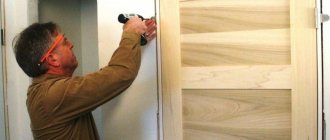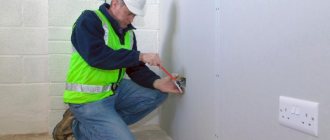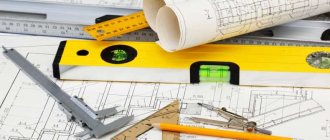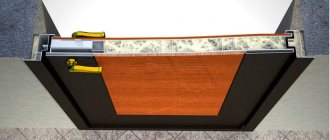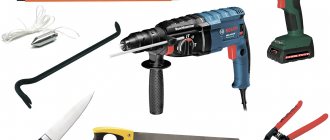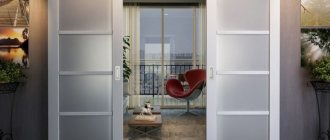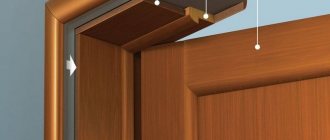Doorway
Setting up a gym in your own apartment is a great idea that allows you to conveniently exercise at home. Not everyone can afford to buy expensive exercise machines and full-fledged sports equipment, and there is often not enough space in the apartment. However, there is a good alternative - making a horizontal bar in the doorway with your own hands. It will not take up space and will allow you to train at any time.
Option for installing a horizontal bar in a doorway
Kinds
In total, there are three types of horizontal bars, which differ in technical characteristics and methods of attachment to the doorway (removable and non-removable). When choosing, you need to take into account the individual characteristics of each horizontal bar: for a spacer horizontal bar you will not need additional bolts, but with a sliding bar it is better to buy a couple of spare fasteners.
Sliding
One of the simplest options for sports equipment. It consists of 2 telescopic pipes that are connected and have a common area. Attaches with bolts to the sides of the doorway. After installation, removing such a structure is not an option.
Compared to the faster installation of a spacer bar, which is not fastened with bolts, although this projectile is inferior in terms of installation time, it guarantees much more safety. And also the sliding mechanism is ready to withstand more weight than other analogs, which speaks positively about it as sports equipment.
Spacer
The installation of this model resembles a sliding horizontal bar, but the expansion bar has the advantage: it is attached without the use of bolts, and is held in place by powerful spring mechanisms. At any time, such a horizontal bar can be removed and moved to another location.
Some spacer mechanisms are equipped with an additional fastening system, which includes connections using bolts. This increases the allowable weight that the crossbar can support
The main condition for using such a horizontal bar is caution and proper installation. If you do not follow the instructions, the probability of failure of the structure is high.
An important feature: the material of the walls on which the pipe with springs will rest must be very strong and wear-resistant to deformation. Hard woods such as oak are suitable.
Above the door
This is a design that involves using the free space above the doorway, and not in it. It is attached with anchor bolts and does not interfere with walking through the door, because it hangs much higher than the opening. Of all types, it is distinguished by improvements: the over-the-door horizontal bar often contains handles for different grips and exercises.
Thanks to the free space that will not be limited by the door frame, there is more freedom of movement. It is the over-the-door horizontal bar that allows you to do a full pull-up without thinking about the safety of your head.
Varieties
There are 3 types of horizontal bars for doorways. Each of them has special technical characteristics and a different installation method:
We must not forget that spacer bars for home use are intended only for strong, stable doorways. Otherwise, it will lead to deformation of the structure or wall. If a person wants to play sports in the most comfortable conditions, using different types of grip, the over-the-door option will be the best.
Assembling a wall horizontal bar
You need to choose the right steel that you use. An ordinary pipe containing ferrous metal will do. After the welding has been carried out, it must be stripped down to metal, treated with a primer and painted. It is quite acceptable for use in apartment conditions.
DIY hanging horizontal bar.
You can also use stainless steel for the horizontal bar, but it is expensive. Food-grade stainless steel will not work, as it has thin walls and will bend. For these purposes, structural alloy steel will be needed. It won't rust. The only caveat is that your hands can slip with it, you will have to wear gloves. If the door frame is weak, do not place the horizontal bar; it will not hold up. To install a simple horizontal bar, it will take only 3 hours.
Alloy steel is the best material for a horizontal bar.
Welding is a necessary element for work.
How to make a horizontal bar on the ceiling with your own hands
This option can be considered the most creative, but not the most practical. The thing is that the fastener in this case works in tension, and not in shear as in the previous examples,
This means that it can break out of the floor slab, that is, from the ceiling. Therefore, special attention should be paid to fastening, that is, use dowels with a diameter of 8-10 mm, and it is also advisable to duplicate the fastening. We will give two examples
The first example of a horizontal bar for a ceiling actually repeats the design of a horizontal bar for a wall, except that it is attached not to the wall, but to the ceiling.
The second option is even more unusual. Two dowels with loops are attached to the ceiling. We attach a rope to the loops, and a crossbar on it. Moreover, in our case, the crossbar is completely made of wood, from a trunk. As a result, this can be considered the most budget option for the home, but not the worst. The advantages of such a horizontal bar are obvious; it is located on the ceiling, where there is most space in your apartment. It can be easily removed by unfastening the carabiners. The horizontal bar can be adjusted to suit any height, even to the point of making a swing out of it. So this option is quite worthy of attention. The only significant disadvantage will be that it will sway excessively when using it.
And to complete our options, we would not want to stop only at apartments, which means we will consider another option, when the horizontal bar is made for a dacha, for the street.
How to make a horizontal bar for an apartment with your own hands photo report
Even for the most complex wall model, 2-2.5 meters of profile pipe and about 1.5 meters of round pipe are enough. To make a horizontal bar for your home with your own hands, a sheet with the selected model and dimensions is pre-printed. For the frame, a profiled metal pipe 20*30*3 mm was used, for the crossbar and “handles” - a remnant of a curtain rod from Soviet times. The pipe is thin, but still holds up. To begin with, using a grinder, I sawed the profile pipe into pieces of the required length.
Beginning - cut the pipes into pieces of the required length, file the angle of the stops
There are no corner stops in the diagram; they are made “by eye”. The angle is about 50°. The next thing to do is cook. With an inverter welding machine this is not too difficult. Moreover, the pipe has a thick wall: 3 mm is welded normally.
The result is two halves of the frame in the shape of the letter “G” - they need to be connected by jumpers. To ensure that the frame posts are parallel, we use strips that fix the parts at the same distance. At the same time, from scraps of stainless steel pipe, we weld handles at the bottom, which we will hold on to when pumping the press.
To ensure that the distance between the posts is the same, we use slats
To make a tight connection between the round pipe and the rectangular one, a semicircle was cut out in the stand using a grinder. I had to modify it with a file, but the fit is very good. All that's left to do is boil it.
Design of the junction of a round and rectangular pipe
To weld handles for a narrow grip to a round pipe, we also form recesses in the pipe sections. It is more difficult to cook them - the thickness of the pipe is much less. In general, other electrodes are suitable for welding stainless steel. Due to lack of experience, the seams turned out ugly, but without obvious defects.
Next you need to bend the pipe along the edges. To do this, insert a rod of smaller diameter into the pipe, take a gas burner, heat the bend, bending it little by little. You need to bend it 30°. To do this, I drew an angle on the floor with chalk, bending it and checking it against the drawn lines.
Add “holders” for a narrow grip, bend it and you can paint it
We put an emery wheel on the grinder and clean the welding areas. Then, using a circle with a smaller grain, we remove plaque from the entire structure, additionally sanding the seams. Ready for painting. Spray paint was applied in three layers.
We also made the hooks for hanging the horizontal bar ourselves
For wall mounting, hooks are made from a 15*4 mm metal strip. It was not easy to bend - holding the whole piece in tongs, we managed to bend it on both sides. The finished hooks were cut to the required length and holes were drilled for the dowels. A drill with a diameter of 8 mm was used, drilled 12 mm for the fastener heads. The hooks are cleaned and painted with the same paint.
Before making a horizontal bar, decide on the place where you will hang it. Not all spouses will calmly accept such an innovation... Homemade horizontal bar 3 in 1 on the wall in two working positions
Almost everything is ready. All that remains is to make pillows for the shoulders. For the base, pieces of plywood were taken, on them - thin furniture foam rubber in two layers, covered with eco-leather with holes. To fasten the leatherette, staples and a construction stapler were used, but you can also use furniture nails if you don’t have a stapler.
Making pillows for the shoulders
Based on operating experience: wall hooks should be made longer, with at least three dowels. And one more thing: the design has been improved - the handles for a narrow grip in the version shown in the picture are uncomfortable, so another crossbar was welded.
Crossbar added
The homemade homemade horizontal bar turned out to be a bit heavy - 19.8 kg, but in this form it is more convenient.
In conclusion, a short entertaining video prank “Grandfather punishes turnstile makers.” Be healthy!
https://youtube.com/watch?v=rdm-v54q0iU
Selecting material for the horizontal bar
There is always a place in the hallway of an apartment for a homemade horizontal bar. Metal pipes are suitable for this. They have different cross-sections - rectangular (square) and round. Square ones have good rigidity and can withstand heavy loads.
DIY metal crossbar.
When a pipe is crushed, the rectangular shape can quickly break, while the round one will gradually bend. To prevent this from happening, the walls must be thick, 2.5 millimeters or more.
We attach the horizontal bar well to thick walls.
The horizontal bar made from this material is heavy, but reliable; it is not afraid of overloads.
The horizontal bar is a metal pipe.
Stable condition and weight that can be withstood are two main components of the characteristics of each horizontal bar. When making this projectile yourself, you will have to make sure how reliable and stable the materials are.
We choose the material for ourselves and make a horizontal bar.
Another point is that the pipes for this sports equipment are chosen to be easy to use. Of course, it is better for your hand to grasp a round shape, and a rectangular one is easier to weld. It fits better on the wall, having a larger area of support. The racks are made of profiled pipe, and a round pipe is suitable for the crossbars.
Horizontal bar with round bars.
Sometimes wood is used in the construction of this simulator. Wooden structures are less durable than metal ones. And besides, tree species are heterogeneous, and it is unknown how they will behave under load. Jerks when moving during training are inevitable, then the wooden crossbar may crack.
DIY wooden horizontal bar.
If you are not a professional carpenter and are far from wood species and woodworking, leave this idea and don’t waste your time. A metal horizontal bar will suit you better.
Wood is good, but metal is better.
What exercises can you do?
Pull-ups are performed on the home bar, due to which you can pump up your biceps and triceps. If you just hang on the horizontal bar, the spine is relieved and scoliosis is corrected. Different types of training have been invented, each of which is aimed at developing endurance, flexibility and increasing speed-strength abilities.
Exercises with leg raises help pump up the abdominal muscles, and while swinging, the muscles of the arms and back develop. The load is selected individually, taking into account the physical condition and the presence of health problems. For example, if you have sore joints, it is not recommended to hang on a horizontal bar.
Source
Horizontal bars in the doorway
Common designs of horizontal bars for doors are shown in Fig. They are not very suitable for self-production: curved rods-“horns” are subject to high loads due to the large ratio of the lever arms, so they need to be made from special steel
And, please note – assembly is bolt-on only. Welding seams under such loads are unreliable
Horizontal bars for industrial doorways
The situation is even worse with the loads on the attachment point to the wall. There the shoulder ratio reaches (10-15):1 and colossal loads arise, and the wall in this place is, as a rule, weakened. If the main athlete in the house, leaving, forgets to remove the horizontal bar, and the weaker half needs to close the door, then it won’t be long before injury: during the installation/removal process, a piece of iron weighing 20 kg inevitably ends up above your head. In general, home horizontal bars of this type are more of a marketing ploy.
Unsuccessful methods of attaching a horizontal bar to walls and ceilings
More useful and certainly more reliable would be a homemade horizontal bar installed in a doorway or corridor in a spacer or on side holders. There are certain subtleties here. Firstly, the removable crossbar (neck) inserted into the U-shaped pockets (on the left in the figure) will inevitably give some play. Exercising while the bar is moving in your hands is inconvenient and not very useful, but what’s worse is that sharp instantaneous loads are transferred to building structures. Which are not designed for them at all. Rigid mounting to the ceiling (in the center) is little better; a human athlete is not a chandelier. And soft fastening with concentrated loads on the right is absolutely unacceptable.
Reliable fastenings of home horizontal bars in openings
The amateur design of the horizontal bar in the opening is shown in pos. 1 pic. The thrust bearings of the installation units are 5 mm steel sheet. The possibility of removing the neck is provided by an elongated slot in it at one end; the crossbar itself is shorter than the width of the opening. Longitudinal slots in the clamps of the mounting units ensure a tight clamping of the neck when fastening with bolts. The reliability conditions for such a design are as follows:
- From the end of the elongated slot to the edge of the neck - from 30 mm;
- The slots in the clips should extend beyond the rear edges of the bolt holes, but not more than 3-4 mm;
- The solid edges of the installed neck must protrude beyond the inner edge of the slots in the clips by at least 30-40 mm.
The disadvantage of this design is the “cartridges” sticking out of the walls for approx. by 120 mm. The design with the crossbar clamped with nuts (item 2) makes it possible to reduce the overhang of the fastening units to 50-60 mm, but it still sticks out, and the threaded pins are more dangerous than clips made from pipe sections.
The design of the horizontal bar in the opening is optimal in terms of mechanics and ergonomics - with the bar attached to the rails, pos. 3. The “self-tapping screw” is shown there conditionally; in fact, it is an M12 bolt in an anchor buried at least 130 mm into the concrete. The advantage of this fastening is also that you don’t need a tool to install/remove the neck: the thread of the screw spacers at one end is right-handed, and at the other – left-handed. To install, place the bar in place, unscrew the spacers until they rest lightly on the bonks, and turn the bar by hand. Just don’t overdo it: the fixation is “dead” even with a slight twist; If a healthy man touches you with his “claws”, then, no matter the hour, you will have to remove the horizontal bar with a grinder. The disadvantage of the bonk system is that rather complex turning work is required.
And for children!
In general, a horizontal bar for adults in an opening is, as they say, a palliative. It’s another matter for tough beginners. Static loads from them are less than adults according to weight, and dynamic loads are an order of magnitude lower, because The square of the instantaneous speed of movement of body parts acts here. Therefore, it is permissible to attach a children's horizontal bar in a doorway directly to the door frame, and its supporting structure is made of durable, fine-grained hardwood.
Children's horizontal bar - wall bars in the doorway
The diagram and drawings of a children's horizontal bar of this type, combined with a wall bars, are shown in Fig. Pipes – steel 20x1.5; wooden parts - oak board from 20 mm. Sufficient strength and reliability are ensured by a large number of attachment points. The design and dimensional ratios of the parts of the installation units make it possible to perform some gymnastic exercises.
About the handles
The handles of homemade horizontal bars that sit firmly in place and have a grip are made from heat-shrinkable tubes (HERE) with a diameter 20-30% larger than the outer diameter of the pipe. Sold HERE in radio and electrical stores; shrink by heating with a household hairdryer at full power. One layer of shrink-wrapped TUT has a thickness of approx. 1.5 mm; There may be several layers. Grooved handles can be obtained using narrow rings from the same HERE. In general, cheap and cheerful.
Characteristics
Characteristics of the horizontal bar in the opening
| Crossbar length | 100-120 cm |
| Crossbar diameter | 32 mm |
| Structure weight | 2 kg |
| Permissible load | 120 kg |
The crossbar is made of durable steel pipe, with a steel thickness of 3 mm. At the extreme points of the crossbar, wide nuts for spacer bolts are welded.
The diameter (thickness) of the crossbar at the grip points is 32 mm. The surface of the horizontal bar is covered with a special impact-resistant powder paint, which will retain its original appearance under any impact: impacts, chips, high abrasion from the metal fastening of hanging equipment - boxing bags, TRX loops, children's hanging accessories (swings, rings and bungees).
The horizontal bar is securely fixed in the opening due to the spacer mechanism and additional fixing plates, which are attached to the wall using dowels and self-tapping screws.
It is the spacer with the help of a threaded connection that provides reliable fixation of the horizontal bar in the opening and allows it to withstand loads of up to 120 kg. This horizontal bar is one of the most reliable and safe among the sports equipment we produce.
Types of horizontal bars
Horizontal bars vary in their properties, material and type. Depending on which walls the horizontal bar will be mounted into, it will depend on how high quality and safe such a structure will be.
It is also worth paying attention to the estimated maximum weight that will be used on the horizontal bar. First of all, you need to be very careful in calculating all your options to avoid breakdowns or injuries.
There are also types of horizontal bars that are sold ready-made for doorways and you just need to purchase them. However, this is not always profitable or practical. A mounted horizontal bar, unlike a purchased one, does not require much storage space or incur high costs.
So, horizontal bars in a doorway differ in the following types:
Door horizontal bar. Or a traditional horizontal bar in a doorway. This is the most prosaic and simple horizontal bar for the home, which is familiar to many and is a crossbar that is attached to a doorway or any other opening in the apartment. Also, such horizontal bars can be either removable or non-removable. This is the most budget-friendly, non-bulky and widespread version of horizontal bars. It does not require sophisticated installation or any additional costs. In addition, such a horizontal bar is already found in every second house. However, it has a significant drawback: it is not suitable for everyone. You need to remember the purpose and purpose of the horizontal bar. Not all types of exercise are suitable for all people
Therefore, you first need to pay attention to the health and suitability for the user of such a projectile. Prohibited types of exercises on such a horizontal bar include those exercises that are performed upside down
There are also weight restrictions on such horizontal bars. Such a warning may not seem serious, but this kind of horizontal bar can only withstand up to 130-140 kilograms. The cost of such horizontal bars ranges from 900 to 1600 rubles.
- Wall horizontal bar. This horizontal bar is more reliable and the most functional of all types of horizontal bars, unlike other models for doorways. Such equipment allows you to perform all types of exercises, including exercises performed upside down. Such a horizontal bar must be attached with anchor bolts of 10 millimeters in relation to the vertical position to the wall surfaces. However, such a horizontal bar has limitations during installation: it can only be attached to a concrete or brick wall. This restriction means that such horizontal bars cannot be installed on a plasterboard partition or in panel houses. Also, the wall projectile can be removable and foldable. When the projectile is removed, its fastenings will remain on the wall. The price of a wall-mounted horizontal bar depends on the manufacturer and varies from 800 to 10,000 rubles.
- Horizontal bar parallel bars. This type of projectile can in some way be called a subtype of a wall horizontal bar, since it consists of several transverse crossbars, which are most often installed perpendicular to the crossbars of the handles. The beams are secured with anchor screws. But this does not change the fact that the entire structure can remain removable, allowing it to be attached in several positions. It can also be foldable.
- Above-door horizontal bar. This is a more convenient, simple and compact type of horizontal bar. Such a sports equipment is fixed above the doorway. It can also be conditionally called a subspecies of the wall horizontal bar. This is one crossbar that is located at a distance from the wall with a small gap. During the period of performing such an exercise, the entire torso and legs of the trainee can go into the doorway. This of course may entail some limitations in execution due to the small distance of the wall.
- Corner horizontal bar. This is also conditionally one of the subspecies of the wall horizontal bar, although it is atypical. This horizontal bar is fixed parallel to the corner of the walls.
- Floor horizontal bar. This is not just a sports equipment, but a whole complex of structures. These are parallel bars for performing heavy and complex strength exercises. Depending on the different type and production, such horizontal bars can be equipped with various holders, benches, punching bag and barbells. In such horizontal bars, you can independently determine the position and adjust it to your own preferences. The price of such a horizontal bar can range from 4,000 to 20,000 rubles: it all depends on the configuration and manufacturer.
Schemes and sizes
The horizontal bars diagrams are what is important. Pipe diameters and wall thickness are important. This is really important and the dimensions are approximate. They may vary depending on the height and size of the person. Usually they are given for “average” height and average chest size. If your parameters are larger than “average”, increase the size so that it is comfortable for you.
This model is called three in one (3 in 1), as it allows you to train almost all muscles
Wall models
Some of the most convenient and functional are wall-mounted horizontal bars. Some of them are more bulky and complex in design, and some are quite simple. Let's start with the more difficult ones.
The picture shows a horizontal bar on which you can exercise in two positions. In the picture on the right is a position for working the abs, on the left is for working the arms, back and pectoral muscles. This design can be improved. In the diagram on the right there are two crossbars that are used for working with a narrow grip. You can install additional crossbars for the middle one, and use the outer ones for the “normal” one. A wide grip is provided by handles protruding from the sides. It is more convenient if they have an inclination of about 30°.
Two diagrams of a wall horizontal bar for different grips. Different sizes, similar designs
It is not always convenient to turn the horizontal bar over, so another design was invented - with handles on the front bar. It is less massive and requires fewer pipes. But you will have to pump up your abs on a different machine. This one does not provide such an opportunity.
Diagram and dimensions taken from the finished wall horizontal bar
Despite its shortcomings, the above design has been repeated many times. It is simple, reliable, takes up little space, and is therefore popular. The dimensions are slightly adjusted, leaving the pipe diameters and the thickness of the corners unchanged or increasing the wall thickness. An example is in the photo below.
This is a homemade version made from a factory model
There is an even simpler design. This is only one bar on which you can only do pull-ups. But this design is one of the most compact. It can be hung above the doorway and it will not interfere or attract attention. It makes sense to make a horizontal bar of this design if there is no room to place a more serious projectile or if there is a wall bars.
Sizes - for short height
Above-door structures are among the most compact. The only ones that take up less space are those that are installed in a doorway or between two closely spaced walls (here, all you need is a pipe with special fastenings for it).
Horizontal bars for the yard
More complex structures are usually installed in the yard: there is no need to save space, so they make the most comfortable model possible. At the same time, it is worth approaching the issue carefully: to make a horizontal bar reliable, you need pipes with a solid wall thickness, and they are not cheap. Therefore, since there are already racks and crossbars, you can make a wall bars and a mount for a swing - so that both children can play and adults can train.
Outdoor horizontal bar: drawing with dimensions
Please note that the racks are connected in pairs by jumpers. The jumper is buried in the ground and serves to stabilize the position during lateral loads. Something else to pay attention to is the depth to which the pillars are buried. If the soil is prone to heaving (clay and loam), it is advisable to bury below the freezing depth. In central Russia, this is about 120-130 cm. In order for the racks to stand securely, pieces of pipes can be welded perpendicularly to the underground part. This will complicate installation, but the poles will definitely not become loose.
We do it at the dacha
So she gets much less attention than she would like. First of all, a place is selected for a house and various outbuildings, a vegetable garden, a playground, and a recreation area. So imperceptibly the entire area becomes distributed.
But this does not mean at all that there is no free space where sports equipment can be installed. And in these conditions, a regular horizontal bar on vertical risers will be most in demand.
To install a metal crossbar, you don't need a lot of space. It can be fixed anywhere. In addition, it can be used for sports activities and for beating carpets.
If space allows, you can add a basketball hoop, a sports ladder, parallel bars, or just a horizontal bar.
What is needed for a homemade projectile
Gymnastic standards require that its diameter be 28 mm. But you are not going to world championships, so you can afford a pipe with a diameter of 20 to 35 mm. In addition, it should be smooth and not particularly hard, so as not to hurt your palms. The supports can be wooden poles or metal pipes.
If you have a welding machine, it is better to build a metal horizontal bar. Keep in mind that the cross-section of metal supports should be three times larger than the diameter of the crossbar.
Working out on your horizontal bar should be comfortable. So, for example, for a height of 170-180 cm, its height should reach two meters, and at the same time, the supports will go into the ground up to half a meter.
A drawing that reflects all the parameters of the sports equipment and takes into account the digging depth will greatly facilitate the construction process.
Let's consider the design features of sports equipment, depending on the material of manufacture:
From metal pipes
Working at heights with welding is quite dangerous, especially if you are not a professional welder, and besides, it is not easy. Lastly, install the vertical posts in the previously prepared holes.
Please note: the deeper the shell is dug into the ground, the stronger it will stand.
True, then you will need longer pipes and an earth drill, otherwise it will be difficult for you to make holes of the required depth.
If you are digging to a depth of less than a meter, concrete it with cement-sand mortar (1:3). To fix the supports vertically, it is recommended to support them with wooden wedges. And sand, poured 10-15 cm under the horizontal bar and compacted, will protect from dirt after rain.
The finished projectile should be slightly taller than your height with your arms outstretched. You should begin exercises on the horizontal bar only after the cement has completely set.
From wooden pillars
The crossbar is secured to the posts with staples. Or they drill a hole in the pillars, insert the crossbar into them so that the edges are behind the supports, make holes in it with a drill and tighten it with a screw and bolt.
Between two trees
It turns out that this is possible. Especially if there are two trees on the site, one very close to the other. All you have to do is find a suitable piece of metal pipe and secure it:
- The easiest way is to drive staples into the trees.
- Another way is to drive metal pins into each tree, place a crossbar on them and secure it with wire.
- Nail the pipe or screw it with self-tapping screws.
Whichever option you choose, it should be the one that makes the most sense to you and that the crossbar is securely attached.
Near one tree
It will serve as one support. You'll have to do the other one yourself. A wooden pole dug into the ground will do this role perfectly. And the crossbar is just as easy to attach. One bracket is driven into the tree, the other into the post. For reliable fastening, holes are made in the metal pipe, so you can nail it to the tree much more thoroughly.
Step-by-step manufacturing instructions
3 in 1 horizontal bar drawing
Be sure to choose racks of the correct section or attach the horizontal bar to reliable walls or thick trunks. A drawing of a wall horizontal bar with 3-in-1 or 2-in-1 fixtures is first made. For a single floor or overhead crossbar, a diagram for assembling and installing the elements is also developed.
Step by step process:
- sockets are welded onto the walls or racks to fix the ends of the crossbar;
- if the plates are made of wood, they are cut into the door panel or attached to the walls with anchors at the required height;
- try on and cut the bar to size.
The crossbar is placed in the prepared nests. The accuracy of installation is checked with a level; if racks are used, a plumb line is used. In outdoor conditions, a small canopy or canopy is additionally installed over the training area.
Horizontal bar parallel bars
Horizontal bars - consists of two parallel crossbars
The parallel bars are made for narrow and wide grips; such devices, together with a pull-up bar, will cost less than a store-bought model.
The projectile consists of two pairs of vertical pipes. The distance between pairs is 1.5 m, and between opposite elements - 0.7 - 0.9 m. They are concreted in pits at least 50 cm deep. Rigid crossbars made of a round pipe are welded to two racks.
The horizontal bar is fixed on one of the pairs of pipes. It is made to the appropriate height. For children, the principle of making a projectile is similar; the child’s height and the size of his palms are taken into account.
In the doorway
This crossbar is made single, it is not combined with parallel bars or a gymnastic wall. Compact designs ensure that they do not interfere with the movement of people between rooms.
Door horizontal bar models:
- stationary;
- removable;
- folding
The first type involves fixed fixation of the supporting crossbar. To install it, round metal pipes are used, into which the ends are inserted. For removable ones, parts are mounted with a recess in the upper part so that, if necessary, the bar can be removed. Folding ones have a complex structure. When folded, the structures practically do not protrude above or inside the opening.
Between two walls
The structure between the walls is installed in the corridor
Such structures are most often placed in the corridor, where the width of the room allows. Sometimes a folding structure of parallel bars is placed on the side, and a wall for gymnastics is mounted. On the horizontal bar you can build a removable model of a children's swing.
The pull-up apparatus in the corridor area does not take up much space, and the exercises will not interfere with other family members. The ends are fixed on the walls in a blind or removable way. They use pipe fasteners or overhead sockets made of iron, plywood, or wood. For installation, use dowels or metal anchors with a length of at least 100 - 150 mm. The overlays are decorated to match the color of the walls or left in a contrasting color.
Ceiling
The design is chosen if the room has high ceilings, so that the plank is at the height required by the standards.
Standard Parts:
- A round pipe for making a crossbar, its length is usually 1.0 - 1.2 m. The ends of the plank at a distance of 20 cm from the edge can be bent at an angle to the floor of the room.
- Two short pipes (15 cm) for different types of grip are welded perpendicular to the bar. The distance between them is 20 – 25 cm.
- Ceiling elements for fixing, for example plates.
- Square profile for racks.
To the wall bars
Horizontal bar for wall bars
This method is used if there is already a wall in the room, and its height allows you to arrange the horizontal bar at the proper level. Take into account the gap to the ceiling.
The fastening plates are bent to the shape of the wall rods; they are taken with an initial length of about 60 cm. The bent part completely encircles the wall crossbar; a margin of coverage of several centimeters is allowed.
If the ceiling height in the apartment is 2.5 - 2.55 m, some exercises on the horizontal bar will not be possible. The crossbar on the wall bars is combined with a basketball hoop, a climbing rope, and a boxing bag.
Street option
They use metal and wooden supports and install concrete pillars. At the ends of the underground part of the iron and wooden racks, transverse or cross elements are welded or drilled. They are concreted together with the posts to give additional stability to the pillars against being pulled out. Installation will be more complicated, but the racks will stand securely for a long time.
On the outside, they use struts in the form of guy ropes, rigid inclined elements, and the frame in the corners is fixed with diagonal braces. When assembling, holes are drilled for bolts 0.5 mm wider than the hardware. After screwing the nuts, the ends of the bolts are cut off and ground with a grinder.
Horizontal bar finishing
Applying an antiseptic and painting wooden or metal structures are the main types of treatment. When operating and constructing the crossbar, the following features should be taken into account:
- the crossbar should not have a rough surface. Wooden or metal elements are carefully sanded before installation, and painting makes the surface more comfortable;
- when performing exercises, you can use different pads and straps to ensure comfort during exercise;
- The area around the structure should be covered with sand or fine gravel. The children's complex can be located on the lawn, but not on an asphalt surface to avoid injury;
- The paint layer of the horizontal bar should be periodically renewed to prevent corrosion of the material.
A sports device located outdoors requires simple maintenance, but the key to durability is proper installation.
